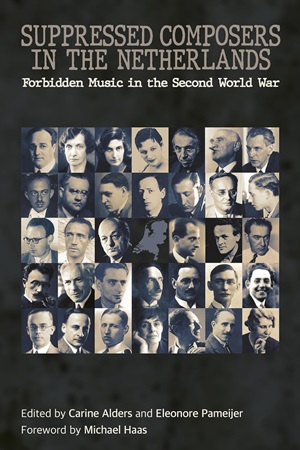
Suppressed Composers in the Netherlands
Forbidden Music in the Second World War
Edited by Carine Alders and Eleonore Pameijer
356pp. Hardback
Published 2024
ISBN: 978-0907689492
Toccata Press
This is a useful compendium of 34 suppressed Dutch composers, with contributions from a variety of musicians and scholars. All featured were persecuted by the Nazis during World War II. Each composer is dealt with comprehensively, and each chapter makes an intriguing and fascinating read. It’s both eminently readable and beautifully illustrated with a generous cache of black and white photographs. We progress through the book alphabetically rather than chronologically.
For the Netherlands, being only a small country, the loss of so many composers, who either died or were murdered, was devastating, and the country didn’t easily recover from this immense depletion of creativity. Even those who survived were culturally sidelined. The music was diverse and covered a wide spectrum from Jan van Gilse’s late Romanticism to the more modern approach of such composers as Daniël Belinfante, Dick Kattenburg and Nico Richter.
The statistics are grim. Of the 34 discussed, 19 were deported to concentration camps, 13 of these were murdered and only 6 survived the ordeal. Persecution was widespread, and music was both banned and the performing of it a punishable offence. The result was that after the War, their music was forgotten. Only in recent times has there been a recognisable rehabilitation of this “lost generation”, and these composers are finally being accorded their rightful place. It’s through the work of such organisations as the Leo Smit foundation, founded in 1996, that revival has taken the form of research, publication and performance. The organisation is named after composer Leo Smit, who was born in 1900 and was murdered in the Sobibor extermination camp on 13 April 1943. Not only did the War result in his untimely death, but it stifled all interest in his music.
To provide some context, many composers, until the end of the 19th century studied in Germany, and the German Romantic Tradition formed the basis of the training in the Dutch conservatories until around 1900. Once the 20th century arrived, a diversity of styles began to emerge. So we have Late Romanticism, the influence of French Impressionism, Neo Classicism and Twelve-Tone music. The French influence can be found in the music of Sem Dresden, Leo Smit, Rosy Wertheim, Fania Shapiro, Simon Gokkes, Julius Hijman and Marjo Tal. Nico Richter, on the other hand, was a proponent of the Twelve-Tone method.
“Entartete Musik” or “degenerate music” was the National Socialist term for music deemed unacceptable within the Third Reich. In the Netherlands, music was banned on racial, not aesthetic grounds. Composers were compelled to sign a declaration of their Aryan origin or become a member of the Chamber of Culture in order for their music to be performed. Once the War ended, these composers were neglected and their music sidelined.
I had heard of several of the composers in this book, but many were new names to me. Bosmans, Chapiro and Frid are all composers whose music I’ve had the pleasure of reviewing, Leo Smit, Zoltán Székely, Nico Richter, Jan van Gilse and Rost Werteim are all composers I’m familiar with through recordings in my collection. The others are all new encounters for me, so it’s been a fascinating discovery reading up and learning about these.
This is a well-researched reference book, not something that one reads straight through from cover to cover. You’ll find it a trusty and practical guide, providing essential reading for all of those interested in the fate of those Dutch composers who were persecuted by the Nazis during World War II.
Stephen Greenbank
Buying this book via a link below generates revenue for MWI and helps us keep free access to the site



















